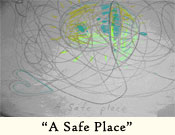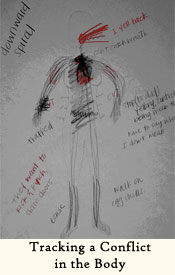|
SOMATIC PSYCHOTHERAPY
Art Therapy | Bodynamic Analysis | Dream Work
EMDR
Hypnosis & Guided Imagery | Journaling |
Somatic Experiencing | Touch Therapy
ART THERAPY
Along with movement and sound therapy (like singing and music), art therapy is among the oldest forms of therapy known to humans, and is inherent to being human. The creation of art accesses the right brain, the domain of color, shape, space, motion, and emotion. When the narrative, left brain, story is unclear, or words are not available for dialogue, art therapy allows self-expression and discovery. Often the act of drawing releases energy and emotion, and individuals feel better. Most are surprised by how much art reveals about themselves. Through metaphor and symbol, we can extend the meaning to other aspects of life. Best of all, you don't have to be an artist to do art therapy. I have completed post graduate art therapy workshops and supervised art therapy interns.
Some resources for Art Therapy are: The Soul's Palette by Cathy A. Malchiodo and Zen Seeing, Zen Drawing: Meditation in Action by Frederick Frank
BODYNAMIC ANALYSIS
Developed by Lisbeth Marcher, a Danish body psychotherapist, Bodynamics is a theory of human development and character structure based on the acquisition of psychomotor skills at specific ages. Beginning with intrauterine experiences, Bodynamics defines seven stages of human development: Existence (second trimester to 3 months), Need (1 month to 1 ½ years), Autonomy (8 months to 2 ½ years), Will (2 to 4 years), Love/Sexuality (3 to 6 years), Opinions (5-8 years), and Solidarity/Performance (7-12 years). How well an individual negotiates the skills needed at each stage of development is reflected in muscle tone and body type, creating a "body map" of personal history. Body awareness and one's perception of physical sensations create a bridge between thoughts, feelings, and actions/behaviors, and often exposes unconscious material. When this body awareness is combined with specific movements related to developmental and therapeutic issues, clients have access to new motor skills and psychological capacities.
For more information on Bodyanimcs, see www.bodynamicusa.com and Body, Breath, and Consciousness: A Somatics Anthology by Ian Macnaughton. I am completing the Foundation Level training.
 DREAM ANALYSIS DREAM ANALYSIS
Dreams are the road to the unconscious, which is always body-based. Dreams can be recorded and explored through journaling or art therapy, and sometimes through movement. Dreams can function to direct our attention to repressed, denied, or split-off aspects of our experience and to integrate them; to compensate for what we are missing in conscious life; to bring us into balance and wholeness; to discover or create meaning for our experience. Good resources for working with your own dreams are The Jungian-Senoi Dreamwork Manual by Strephon Kaplan Williams and Inner Work: Using Dreams & Active Imagination for Personal Growth by Robert A. Johnson.
EMDR
Eye Movement Desensitization and Reprocessing (EMDR) was developed by Francine Shapiro, PhD, as an effective technique for treating Post Traumatic Stress Disorder (PTSD) and other anxiety disorders. Over the years it has been expanded to successfully treat other emotional issues, including grief and loss, depression, dissociation, and addiction, among others. The technique involves identifying negative beliefs and attitudes that arise from life events, and tracking their emotional and physical effects. The eye movements directed by the clinician stimulate the right and left hemispheres of the brain to work together, thereby accessing more aspects of experience, usually with more tolerance. When one feels stuck at a particular level of experience, such as negative thoughts, sometimes progress can be stimulated by attention to another level of experience, such as emotions, sensations, other memories or counter thoughts. Similarly, positive new beliefs and ego strengths can be "installed" with EMDR. I am trained in Level I and II EMDR. For more information about EMDR, look at www.EMDRIA.org.
HYPNOSIS AND GUIDED IMAGERY
Hypnosis uses the trance state elicited by right brain dominance and the parasympathetic nervous system to access the unconscious mind for positive health changes. The deep trance state "turns off" or diminishes the left brain functions of speech, linear and analytical thought, and heightens the right brain functions of intuition, sensory perceptions, and nonverbal communication. The trance state can be used to uncover repressed memories, unconscious motivations, and the origins of psychosomatic symptoms. Similarly, guided imagery uses the relaxation response to access the unconscious and make suggestions for positive health changes through metaphors, symbols, and analogies. I have a year in graduate training in clinical hypnosis at UCLA and post graduate seminars.
For information on hypnosis and healing imagery, look at Your Sixth Sense: Unlocking the Power of Your Intuition by Belleruth Naparstek and The Psychobiology of Mind Body Healing by Ernest Lawrence Rossi.
You carry the cure within you.
Everything that comes your way is blessed.
The Creator gives you one more day.
Stand on the neck of fearful mind.
Do not wait to open your heart.
Let yourself go into the mystery.
Sometimes the threads have no weave.
The price of not loving yourself is high.
- Jim Cohn
printable version |
JOURNALING
James Pennebaker, PhD, has done several studies demonstrating the powerful positive effects of journaling on both our physical and mental health. As memory may be linear (left brain) or cyclical and associative (right brain), journaling accesses both left brain logic and narrative and the right brain sense of emotions and unusual connections. Daily journaling as a check-in allows us regular access to our thoughts and emotions, revealing patterns and themes over time, creating a personal record of change and growth. The practice of writing helps us confront our inner critic and move beyond the urge to censure ourselves, leading to greater self-acceptance. The release of negative emotion in this manner not only decreases anxiety, improves problem solving, and encourages effective action, it can induce physical changes as well, such as improving sleep, restoring appetite, decreasing blood pressure and boosting the immune system.
Some sample journaling exercises:
- Write a letter to anyone against whom you harbor resentment or anger. Do this repeatedly over several days, and watch your anger change.
- If you're experiencing grief or loss, consider writing goodbye letters.
- If you're troubled by physical complaints, try writing from the perspective of different body parts.
- If you're anxious about a particular event or performance, write a script for it going well and read it out loud daily.
- Pick out favorite poems and quotes and respond to them:
Some resources for journaling are: The Artist's Way by Julia Cameron and Writing to Heal: A Guided Journal for Recovering from Trauma and Emotional Upheaval by James Pennebaker, PhD.
SOMATIC EXPERIENCING
Somatic Experiencing is a naturalistic approach to resolving and healing trauma developed by Peter Levine, PhD. Based on his observations that highly stressed animals recover from life-threatening situations through the completion of the "Fight or Flight" response without any remaining trauma symptoms, Dr. Levine noted the same capacity in people.
Humans have this same innate mechanism for completing the "Fight or Flight" response of the sympathetic nervous system and eliciting the relaxation response for rest and recovery through the parasympathetic nervous system. Unfortunately, when we experience traumatic or overwhelming events, this healthy process is thwarted by social circumstances or the rational, thinking brain that suppresses helpful reactions as uncomfortable. This undischarged energy is held in the body as somatic memory and can appear as physical symptoms. With repeated unresolved trauma, syndromes can develop.
Through proper attention and support, Somatic Experiencing directs awareness to resourced (healing) states, initiating "pendulation" between resourced and unresourced states. Trauma "re-experienced" in this way is usually very tolerable to the client, as it is done in small doses, called "titrations. " Titrations are expanded and deepened only as the client's capacity expands. For this reason, trauma work often proceeds at a slow pace, and relief is experienced in increments. Nonetheless, changes that occur this way are more significant for their impact, long lasting, and promote overall health.
I am a Somatic Experiencing Practitioner (SEP) and assist in training new students. For more information on Somatic Experiencing, go to www.traumahealing.org or read Waking the Tiger by Peter Levine, PhD. For more information on the "Fight or Flight" response, see What is Mind/Body Medicine?
Man has no Body distinct from his Soul
for that called Body is a portion of Soul
discerned by the five Senses,
the chief inlets of Soul in this age.
- William Blake
printable version |
TOUCH THERAPY
Traditional psychotherapy does not involve touch between the therapist and client, except as a way of greeting or saying goodbye. This is an important way of keeping clear boundaries between client and therapist.
By contrast, in Somatic Psychotherapy sometimes it is helpful and necessary for an individual to be supported by touch in order to bring awareness to areas of the body and to facilitate the process of releasing the effects of traumatic experience. The human experience includes both conscious and unconscious memory, the latter of which is held in the body in the form of somatic memory. We can experience somatic memory as vague physical complaints and symptoms, and habitual patterns and reactions whose origins we can't trace. Touching an area can help us focus and sense what is going on by noticing our internal reactions, either through emotions, thoughts, or sensations.
Even with touch, appropriate and comfortable boundaries are maintained in Somatic Psychotherapy. It is only done with the client's consent and for a clear clinical purpose. If a client says he or she is not comfortable with a proposed plan, the therapist will not be offended and alternative ways will be found to get to the problem. In fact, saying "no" may be a very empowering and important part of the therapy for clients who have been abused through touch.
Touch in somatic psychotherapy is not bodywork, nor does it directly manipulate body parts or tissues. Touch can be done by the client placing his or her hand on a part of the body, or by the therapist placing his or her hands on a particular area for the same purpose. Touch in Somatic Psychotherapy is never sexual in nature.
Some examples of times when touch can be helpful are:
- Identifying an area of the body for focus and tracking internal reactions.
- Supporting an area of the body to relax.
- Engaging a reflexive action or defense.
- Resourcing an individual with positive sensation or a healthy body function. For example, pressure on the feet can enhance a sense of grounding.
- Calming an anxiety response, by supporting the brain stem or the kidney/adrenal area.
- Connecting with tissue memory.
As a Somatic Experiencing Practitioner, I am currently completing Advanced Level Somatic Experiencing Touch Training with Kathy Kain through the Foundation for Human Enrichment.
|
|  SKILLS & CAPACITIES DEVELOPED
THROUGH SOMATIC PSYCHOTHERAPY
In addition to the ego strengths developed in psychotherapy (such as affect tolerance, reality testing, impulse control, delayed gratification, etc.), somatic psychotherapies focus on body-based strengths.
Affect Tolerance - the ability to experience negative emotions without acting out, hurting oneself or others, splitting off aspects of experience, or dissociation. We begin with the smallest levels of exposure to negative experience and develop the capacity to tolerate larger amounts over time.
Boundaries -
in ego psychology, the ability to set limits with others
and to recognize the limits set by others. In Somatic Psychotherapy, boundaries are also the ability to sense the difference between oneself and the environment, including other people, and to differentiate between internal and external stimuli.

Breath Work - the use of breath and breathing patterns to affect positive physiological and emotional changes, such as calming and centering; containment and affect tolerance, etc.
Containment - the ability to tolerate negative sensations, energy states and emotions without acting out, dissociating, or self-medicating. Also, the sense of being held by the body and its boundaries.
Centering - the sensation of the core of the body self.
Cognitive Restructuring - the ability to recognize negative thoughts as distortions and to reframe them into more positive and adaptive thoughts. Our thoughts inform our attitudes and positions towards life.
Coherence - the natural synchronization between various body systems in a healthy or relaxed state, such as coherence between breath and heart beat; between different diaphragms, etc.
Connection - the ability to be in relationship to others.
Defenses - In psychotherapy, ego defenses are unconscious processes that protect the self from distress or conflict (eg., denial, repression, sublimation, intellectualization, displacement, splitting, projection, etc). Over time, rigid ego defenses stunt emotional growth and lead to dysfunction and symptoms. An important function of psychotherapy is to recognize these defenses and to create sufficient security to reach the unconscious material they hide. Once this material is exposed and integrated, the defenses are unnecessary.
Somatic psychotherapy also focuses on the restoration of appropriate physical defenses and reflexes that were thwarted during developmental or shock trauma (eg., psychomotor movements; muscle activation). Successful completion of a defensive response leads to a sense of competence and security in the body, and reduced trauma symptoms.
Grounding - the sensation of the connection with the ground. Usually sensed in the feet and legs; awareness of support from the lower body.
Health - "wholeness": balance between body, mind, emotions, and spirit.
Mindfulness - the non-judgmental awareness of the here and now, enhanced through sensory perceptions, rather than replaying negative events in the past or anticipating and rehearsing possible events in the future.
Orientation - In Ego Psychology, the awareness of time, place, and person. In Somatic Psychotherapy, the awareness of oneself in place; a primary defensive response to a threat.
Pendulation - the natural rhythm of movement between constriction and release inherent to all physical systems. In Somatic Experiencing, pendulation is also the movement between past events (unresourced state, the "trauma vortex") and the present (resourced state, the "healing vortex").
Relaxation Response - the body's inherent capacity to relax and recover from internal alarm reactions. Facilitated by the parasympathetic nervous system, the relaxation response is the natural antidote to the stress response ("Fight or Flight") facilitated by the sympathetic nervous system. The natural occurrence of the relaxation response is also a sign that the stress response as a trauma reaction has been successfully completed. In Mind/Body Medicine, the relaxation response is elicited by techniques such as progressive muscle relaxation, breath work, meditation, guided imagery, etc. In Somatic Experiencing, the relaxation response is elicited through pendulation and the completion of the stress response.
Resilience - the ability to manage difficult or traumatic experiences without long term negative effects.
Resonance - the ability to sense in one body the physical energy and sensations of another. This unconscious process is one way that humans affect one another, especially when they are in close relationship (such as mother and infant; couple or family; therapist and client, etc).
 Resourcing - the ability to identify and use
positive coping skills for self-regulation.
Resources may include positive memories,
images of helpful people, calming thoughts,
"a safe place", stress-free areas of the body,
physical support, etc. The body also has
inherent internal resources that assist in
defensive reactions: grounding, centering,
balance, boundaries, orientation, etc.
Resourcing - the ability to identify and use
positive coping skills for self-regulation.
Resources may include positive memories,
images of helpful people, calming thoughts,
"a safe place", stress-free areas of the body,
physical support, etc. The body also has
inherent internal resources that assist in
defensive reactions: grounding, centering,
balance, boundaries, orientation, etc.
Self Regulation - the ability to process difficult or negative experience using the body's inherent mechanisms, such as pendulation and discharge. Effective self-regulation decreases negative coping, such as alcohol, nicotine, drugs, excessive spending, gambling, etc., and increases the capacity to manage trauma effectively.
Somatic Memory - the body's ability to hold the physical sensations and disruptive energy patterns of past trauma, even in the absence of a clear narrative or a conscious association between the initial cause and current symptom. When somatic memories are engaged in a clinical setting, they can be resolved.
Somatic Symptom Relief - the resolution and disappearance of physical complaints as the trauma response is completed and energy is released back into the system. Numerous symptoms that can be relieved in this manner, including head aches, digestive problems, pain syndromes, etc.
Stress Response - the body's innate alarm system in response to a perceived danger, also called the "Fight or Flight" response. The Stress response was first noted by Hans Selye, a Canadian researcher, who described it in three stages: Alarm (when danger is perceived); Resistance (when the body's defenses engage); Exhaustion (when the body rests and recovers). The Stress Response is highly adaptive to danger and human survival when threats are physical, but less so when threats are emotional, psychological, or imaginary. It is also very debilitating when stress is chronic.
 Tracking - The ability to identify,
follow, and report changes in
physical sensation throughout
the body, and to connect these
changes to thoughts, emotions,
and the release of trauma responses
Tracking - The ability to identify,
follow, and report changes in
physical sensation throughout
the body, and to connect these
changes to thoughts, emotions,
and the release of trauma responses
|
|






